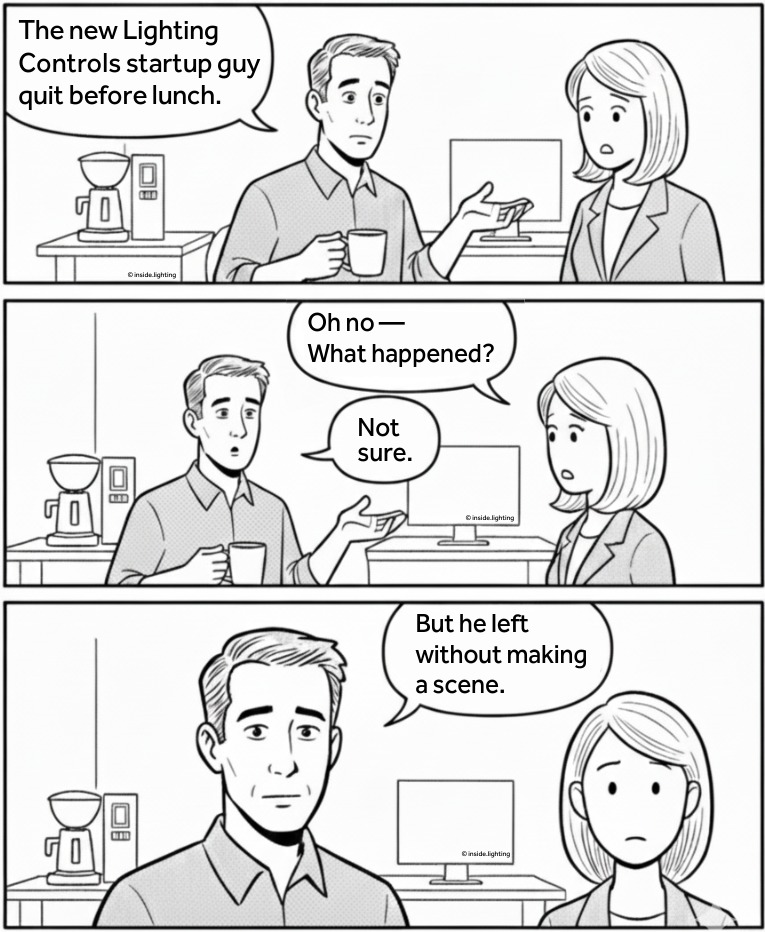June 17, 2025
How to Start Up a Lighting Controls System Effectively

Author: C. Webster Marsh, contributor to the Lighting Controls Association
Follow these essential steps to ensure optimal lighting system performance
Networked lighting control systems play a crucial role in optimizing lighting energy use, enhancing occupant comfort, and interacting with building automation systems (BAS). However, simply installing a lighting control system does not guarantee it will function as intended. This is where a startup comes into play.
What is a lighting controls startup?
A startup is a systematic process for verifying installation, programming devices, testing device functionality, and documenting that the lighting controls are installed, tested, and capable of operating according to the control intent narrative (CIN) and/or sequence of operations (SOO). Some manufacturers refer to startup as programming only, and, creating further confusion, “startup” is often substituted for “commissioning.” Commissioning involves a much more comprehensive quality assurance process by a third-party Commissioning Provider, whereas in the context of lighting controls, startup typically happens towards the end of the installation process. For this article, the term “startup” will be used to refer to installing, programming, testing, and documenting a project.
Who does the startup?
The people responsible for performing a startup’s tasks are Startup Technicians (a.k.a. “field technicians”). Startup tasks can fall to any number of people, and because of this, can sometimes be overlooked altogether since each person potentially responsible for the startup might assume someone else is doing it. This is why it is critical to identify who the Startup Technician is as early as possible in the project execution.
Sometimes it is possible to identify the Startup Technician during the design process, especially if a Lighting Control Systems Integrator (LCSI) is involved as they often can fill this role. Other times, the Startup Technician is identified after the bidding process. It is important that this person or group needs to be identified before equipment is purchased, as some manufacturers provide their own technicians and others do not. It is essential to confirm with the manufacturer during the submittal process whether they will provide a Startup Technician as this will impact on the overall cost of the system.
How is startup specified and estimated?
Startup requirements should be called out in the written specifications, where installation requirements or procedures are defined. Some specifiers may have an entire document dedicated to integrators, wherein they define the startup procedures, requirements for Startup Technicians, and any additional tasks required during startup.
Estimating startup time can be difficult since project size and complexity dictate the required time. The manufacturer or manufacturer’s representative are often reliable sources for time estimates, especially if they plan to use their own personnel. Since each manufacturer has a different process for startup, time estimates will vary among manufacturers. Regardless, a realistic time estimate requires a thoroughly written SOO. Manufacturers and reps use the SOO (ideally, in addition to other documents) to assess device quantities, settings, and unique requirements.
What is the typical startup procedure?
The startup procedure will vary based on project size, complexity, location, regulations, and lighting controls brand, but a typical startup involves the following steps:
- Submittal Review: The Startup Technician will review the approved submittals to understand the system. Since the submittal should contain all pertinent information, it is rare for a Startup Technician to review construction documents in addition to the submittal. This is why it is recommended that the lighting controls submittals be revised and resubmitted before startup, especially if there are significant changes.
- Pre-Wire Meeting: After the submittals are approved, the Startup Technician should hold a meeting with the build team to review the system. This is often called a “pre-wire” meeting. This meeting helps the technician familiarize the build team with the system and address any concerns they may have.
- Preparing the Site: The project site needs to be prepared before the Startup Technician’s arrival. Each lighting controls equipment manufacturer has different requirements for site preparation, but it is common to require that the entire system be wired and accessible, have power available, have all luminaires installed, and, if a network connection is required, that connectivity and internet service is available. Startup Technicians may need to be scheduled weeks in advance. If they arrive at a site that is not ready, a return visit will be required, potentially pushing the completion date further out and increasing the project’s overall cost.
- Installation Verification: The Startup Technician will review the system, ensuring all hardware is wired correctly and according to the approved submittals. Some manufacturers require that the system be unenergized (no power) until this step is completed.
- Programming: In this step, the technician configures the devices to meet the SOO requirements. Some manufacturers provide services that can either reduce the programming time or eliminate it entirely, such as preprogramming their devices at the factory before shipping or offering devices with “commission-less” capabilities, where they function immediately after being powered.
- Testing: The technician in this step will confirm that all components respond and perform as intended per both the SOO and any site changes that may have occurred. This may include a walk-through with the design team and/or an owner’s representative. Based on this feedback, it is common to identify minor adjustments to system programming. It should be noted that the start-up technician will follow the contract documents and will not deviate based on verbal requests. Although minor adjustments are common, more significant changes that could impact code compliance, functionality, cost, etc. should be requested through the specification entity.
- Functional Performance Testing: This process is a regulatory and/or code requirement to provide a certifying document stating that the system complies with code. This is commonly required to be executed by a third party.
- Documentation and Training: The technician will provide the owners and operators with detailed records and system instructions. Depending on the size and complexity of the system, this step may span multiple days and require hands-on training. This step may involve the design team, owners-representatives, and site users, as well, so availability of personnel should be confirmed in advance.
- Follow-up: The project’s overall success requires that the occupants use the system and then adjust it based on their needs. The technician should be scheduled for a return visit after the first year of occupancy to review the system performance with owners and operators. This step may lead to additional programming and testing time.
Tools used in the lighting controls startup
Networked lighting control systems involve various devices, software, and integration paths. Because of this, starting such systems may require a range of specialized hardware or software tools, some of which may only be available from the system manufacturer. Unless it is explicitly stated that the system does not require specialized tools, it’s best practice to assume that additional equipment or software will be required to start a networked lighting control system.
Startup tools generally fall into the following categories:
- Software Configuration Tools: Many lighting control manufacturers use proprietary startup software that provides a user interface on a smartphone, tablet, or laptop for configuring and managing devices.
- Graphical User Interfaces (GUIs): These allow Startup Technicians to visualize the layout of lighting zones, group luminaires or devices, and configure settings like occupancy timeout, daylight setpoints, and dimming levels.
- Cloud-Based Platforms: These tools enable remote access, monitoring, and programming and are especially useful for large or multi-site projects. Cloud-based configuration tools need internet access in addition to connections between a network device and the manufacturer’s equipment, which requires planning and coordination with the site IT installers in advance of the startup.
- Mobile Apps: Mobile Apps are used in many wireless and Internet of Things (IoT)- based lighting systems. Apps allow Startup Technicians to program devices via Bluetooth or Wi-Fi on-site. It is important to note that many apps have minimum performance requirements for smartphones and laptops, and that some apps only run on specific platforms, such as iOS.
Examples of software configuration tools include:
- Acuity Brands’ nLight SensorView
- Autani’s Keilton Network Lighting Control APP
- Avi-on’s Mobile Commissioning
- Casambi’s App
- Cooper’s WaveLinx LITE
- Current’s NX Connect Lighting Controls App
- JDRF’s Electromag Enterprise Cloud
- Legrand’s Wattstopper DLM and Wattstopper PLUS Design and Programming Software
- Leviton’s Lumina RF Lighting Control App
- Lutron’s Vive Hub Dashboard
- MaxLite’s c-Max App
- mwConnect’s TruBlue Web Portal
- RAB’s Lightcloud Blue App
- Synapse’s SimplySnap Cloud
- Toggled’s App
- Hardware startup tools: These tools are used onsite instead of or in addition to software configuration tools to verify and/or alter device operation and programming. These hardware tools often offer more limited capabilities than software configuration tools. Still, they can be ideal for projects for which a software configuration tool cannot be used.
- Testers and Meters: Devices like light meters and occupancy simulation tools help test sensor responsiveness and accuracy.
- IR or RF Remotes: Remote control devices may be provided for some systems instead of a software configuration tool. These dedicated remotes are used to program devices and/or make quick adjustments to the system. Infrared (IR) remotes require line of sight to transmit information to the intended device (like a TV remote), but they typically require less power to operate than Radio Frequency (RF) remotes, which use a radio frequency, like Bluetooth or Wi-Fi, to communicate.
- Gateways: Gateways connect to the lighting controls network and may be required for GUI or cloud-based platforms. These devices connect the system to the internet, route data for multiple devices, manage networked devices, run diagnostics, and/or update device firmware. Many systems require that the gateway be permanently installed on the lighting control network, but Startup Technicians might also bring their own gateway to a project specifically for a startup. In this case, technicians will temporarily connect the gateway to the lighting controls network for configuration.
Examples of different types of hardware startup tools include:
- Acuity Brands’ nLight SensorView
- Current’s NX Area Controller
- JDRF’s Autonomy Gateway
- Legrand’s Wireless Commissioning Tool
- MaxLite’s c-Max Basic Control Remote
- Toggled’s Gateway Edge Computer Device
Emerging trends
As lighting control technology evolves, so do the tools used for startups. Some notable trends include:
- Open Protocols and Interoperability Tools that support open standards like DALI-2, BACnet, and KNX allow greater integration flexibility across different platforms. Since the protocols are open, there are many options for third-party software and hardware to manage the systems, giving technicians a wider range of tools.
- AI-powered diagnostics and machine learning appear in some systems to analyze usage patterns to alert technicians to anomalies. This reduces the time spent on manual troubleshooting or readjusting set points. In specific systems, devices self-identify and auto-configure upon installation, with software auto-generating layouts and control zones, significantly reducing time and errors.
- Augmented Reality (AR) Interfaces are tools that overlay device information onto a real-world view through a mobile device, helping technicians locate and configure devices in the field.
Conclusion
Startup for lighting controls is a vital step in ensuring that networked lighting control systems deliver the promised energy savings, functionality, and user experience. With a growing emphasis on smart buildings, sustainability, and user-centric design, the importance of proper startup is only increasing.
By leveraging a combination of tools and devices, Startup Technicians ensure that every lighting control system is installed, tested, and capable of operating according to the control intent narrative (CIN) and/or sequence of operations (SOO). Whether in a small office retrofit or a sprawling hospital campus, the right startup tools make all the difference between a lighting system that performs brilliantly and one that leaves users in the dark.
The Lighting Controls Association is a council of the National Electrical Manufacturers Association that provides education about lighting control technology and application, including articles, videos, design awards, news, resources, and Education Express, a free, 24/7 series of online courses covering everything from technology to design to commissioning.










